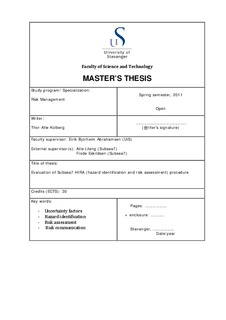| dc.contributor.author | Kolberg, Thor-Atle | |
| dc.date.accessioned | 2011-11-29T08:35:16Z | |
| dc.date.available | 2011-11-29T08:35:16Z | |
| dc.date.issued | 2011 | |
| dc.identifier.uri | http://hdl.handle.net/11250/182064 | |
| dc.description | Master's thesis in Risk management | no_NO |
| dc.description.abstract | The main safety technique used for Subsea7 work activities is hazard identification and risk assessment (HIRA). This process shows how the work activities are conducted, supervised and managed correctly, in accordance with approved practices. The biggest challenge is communicating the risk out to the people executing the work. Make them understand the risk tied to the work.
The goals with this master thesis were comparing different uncertainty factors and evaluate the different methods used in HIRA procedure. See what type of uncertainty tied to the procedures. What methods that are best in Subsea7 type of operations. Finally investigate the information received from the vessel.
Uncertainty tied to the HIRAs
The main purpose was to prove that Subsea7 had to take uncertainty into the calculation of risk. It shows that the risk description can be split into two parts, one covering events and consequences, and another that covers uncertainty. This acknowledges that risk cannot only be described and evaluated by referring to probabilities and evaluated consequences. It needs to be evaluated together with an uncertainty factor U. If Subsea7 implement factor U they will reduce the hazards from occurring.
Methods used to identify measure and communicate risk
Subsea7 HIRA contains parts of different risk identification methods and that is important for getting a better risk picture of the operation. The different techniques that are implemented are guidewords and task analysis. But it should also implement parts from SWIFT like “what if analysis”, this will question the procedures more. Also use FMECA on critical equipment so they don’t risk the whole operation stopping. That should give them better information about where the hazards are hidden. The best way of preparing the procedures is a combination of al the method evaluated, but that is time consuming.
The HIRAs are a good tool for finding the hazards and calculating the risk level, but it can be improved by more precise information about where danger is hidden. Subsea7 can try to upgrade the HIRAs with one or two columns. One with cause (cause of hazards) and split the corrective measures in proactive measures (actions that prevent hazards from occurring) and protective measures (measures that protect people, assets and environment from the hazards). That way the evaluated risk will be easier to communicate out to the people doing the work and they will understand the risk better.
The majority of employers who responded to the survey generally felt “safe” regarding offshore hazards and “satisfied” regarding safety measures on board their vessel. The respondents felt that the communication between the office and vessel could be better, and make the safety procedures user-friendlier. That could be something to focus on when management are making the new safety procedures for Subsea7. | no_NO |
| dc.language.iso | eng | no_NO |
| dc.publisher | University of Stavanger, Norway | no_NO |
| dc.relation.ispartofseries | Masteroppgave/UIS-TN-IØRP/2011; | |
| dc.subject | risikostyring | no_NO |
| dc.title | Evaluation of Subsea7 HIRA (hazard identification and risk assessment) procedure | no_NO |
| dc.type | Master thesis | no_NO |
| dc.subject.nsi | VDP::Technology: 500 | no_NO |
